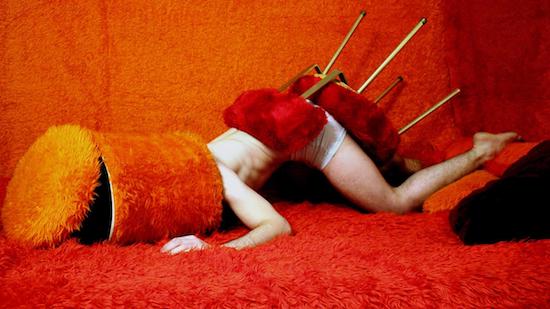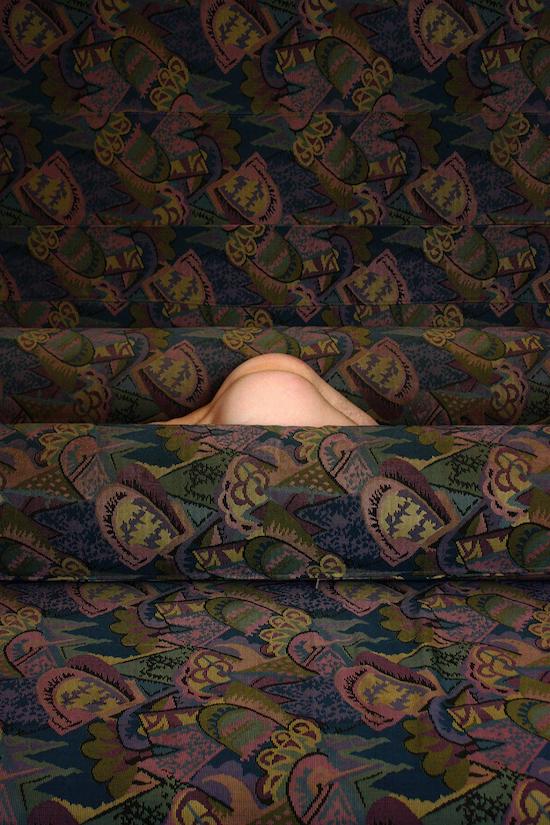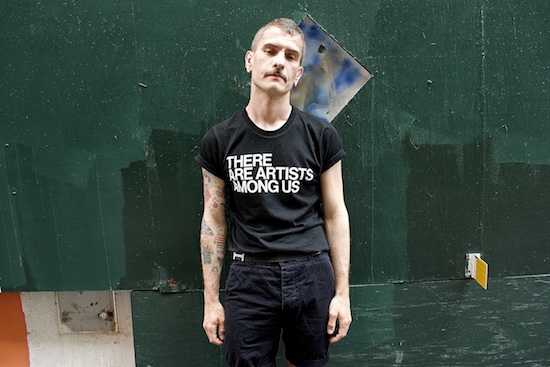The photography of French artist Mehryl Levisse is a deeply personal practice. His meticulously and ornately staged photographs seem to juxtapose his personal passions (film, theater, visual art, and sex) with his particular French rural upbringing in Champagne-Ardennes, an agricultural area near the Belgian border, and family mythologies. The resultant photographs are gripping, and haunting, and they read as the projected images of the deep well of memories and limitless imagination of a fiercely talented artist.
Levisse’s work derives its spirit from both memories and fantasies, and proves, too, that after time, memories become just as dream-like as the most vivid of fantasies and desires. “These are images that I’ve seen somewhere, but I’m not sure where,” says Levisse through his thick French accent. “I’m looking for the sources of the images in the work.”
Levisse’s recent and first New York solo exhibition at Catinca Tabacaru gallery, Birds of a feather fly together, illustrates an artist genuinely using photography as a means to an end, and not an end in and of itself. For Levisse, the photographic image merely completes the work. But it’s also his ornate set-building – chock-full of intricately patterned BDSM masks, wallpaper influenced by the natural surroundings of his homeland, and various props loaded with pathos – that truly provides a direct link between what the viewer sees in the image and what Levisse sees in his mind.
Levisse has a taste for performance and theatrics, and his installations rarely come without the possibility for performative gestures: this exhibition featured four photographs, six BDSM masks, and two performers dressed in creepy face-concealing costumes that haunted throughout the space decorated in Levisse’s handcrafted antique-looking wallpaper based on the homes of his childhood.
Growing up secluded from any bustling cities and deep in the rural countryside of Charleville-Mézières imbued in Levisse a rich inner world. He grew up with the need for real experience and, as a result, the full effect of his work cannot be felt through the buffer of a computer screen. “I was outside of the constant flow of images and my imagination was enriched by movies, by music, and by theatre,” says Levisse. “The things I could see with my own eyes, and not through a screen.”
The nuclear unit of the family, and family traditions and history, are perhaps Levisse’s artwork’s defining characteristic. While viewing his images, one is imbued with that same sense of simultaneous comfort and deep-rooted, long-dormant anxiety that is associated with a family reunion. To be sure, Levisse has a complicated family history, but one still marked by a strong relationship with his parents and a deep, long running fascination with his family’s history and traditions. Much of that difficulty he found within his background did arise from his sexuality. But, it was perhaps more self-inflicted than a result of a disapproving family.

Mehryl Levisse, La Monture, courtesy of the artist and Catinca Tabacaru gallery
When Levisse first realised that he was gay, he is honest about having simply not wanted to be gay. In his rural French culture, gay meant “effeminate,” or “fairy,” or “pink,” but Levisse always felt masculine and took pride in his masculinity. Perhaps due to these cultural misnomers about gayness and masculinity, Levisse ultimately began cutting himself and later spent time in a mental institution. He eventually came to understand his sexuality as just that, a sexuality. “I had always envisioned this kind of gay cliché,” he said. “I wanted to be seen as an artist. As a man. I didn’t want people to project onto me this single image of me being a gay. Now, I’m so proud of my sexuality. I’m gay. But I’m not effeminate. I’m a man.”
His parents, two former photographers, encouraged Levisse to pursue his creative passions. He first studied dance before going on to attend Université de Paris to study art. When he started taking photographs, he would often scout locations for hours at a time but could never find a location that matched the image that he saw in his mind’s eye. “Now I create the sets,” he says. “And have for the last five years. I create the space for a certain kind of energy.”
These sets that you see in the image – and that he also recreates within the gallery’s walls – serve to heighten the implication of the viewer in the act of voyeurism. Looking at art, and erotic photography specifically, is a voyeuristic joy, but this notion is amplified when considering that these images are direct recreations of Levisse’s fantasies and personal history.
There are artistic antecedents to this approach of course; Levisse cites the violent contemporary take on religious imagery of Andres Serrano (particularly fitting in that Levisse, too, subverts a traditional nuclear idiom in the concept of family), the grotesque photographic abstractions of Joel-Peter Witkin, and the avant-garde puppet assembling of Egyptian contemporary artist Wael Shawky as influences. Though he doesn’t claim any affinity for the artist, one could also detect similarities to the iconic colour work of the late New York fine art photographer Jimmy De Sana in Levisse’s similar use of erotic imagery that feels far more whimsical and humorous than actually sexy. “It’s not just about the costume, or just the body, it’s about the identity,” says Levisse. “I want a real connection between the space that I’ve created and the body pictured.”

Mehryl Levisse, Faire Tapisserie, courtesy of the artist and Catinca Tabacaru gallery
An artist once said that photography is perhaps a better representation of the artist’s inner world because it is not encumbered by clumsy hands, and Levisse’s work certainly illustrates this. The spaces in his photographs are drawn from the domestic interiors that he grew up with but are imbued with a haunting anxiety that illustrates the conflicted feelings that bubble to the surface when thinking about things like family and childhood that any viewer can relate to.
Levisse takes this concept even further, turning an exhibition space into an extended reality of the image itself. In his exhibition at Catinca Tabacaru, for instance, Levisse cloaked the entire space in wallpaper reproduced from an image that Levisse shot in the woods in his home of Champagnes-Ardennes, instantly inviting the viewer into his own personal space of dreams, fantasies, and memories. Mimicking the subjects in the photographs, all of whom have their faces hidden from the frame either through positioning or masking, Levisse constructed elegant BDSM masks that are displayed in the centre of the floor. It is a very new and exciting way to engage with photography, and perhaps a way forward for art photography to continue to flourish in an overwhelmingly image-saturated digital culture.
Levisse is mapping out his dreams, desires, memories, and anxieties for the world to see. The photograph for him is just the tip of the iceberg. It is the last element of an encompassing, painstaking artistic process. And like the best art images, Levisse’s work conjures a world that the viewer can’t help but be seduced into wanting to enter, and absorb, and live in. This is what a true artist’s inner world looks like.
Work by Mehryl Levisse is currently included in group shows, including Tous, des sang-mêlés, at MAC-VAL, Val-de-Marne; Printemps de l’art contemporain at Atelier Tchikebe, Marseille; CHASSÉ-CROISÉ at the château de Champlitte, Haute-Saône


